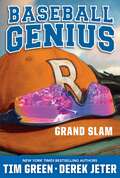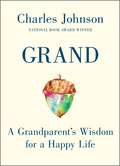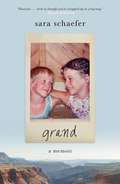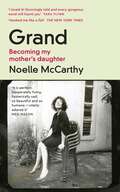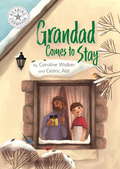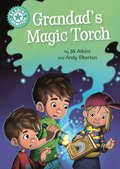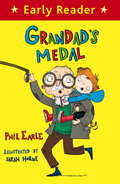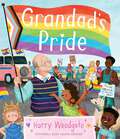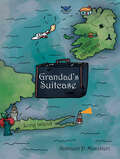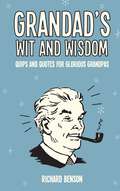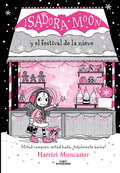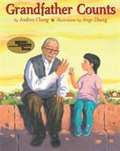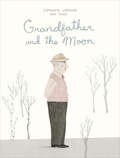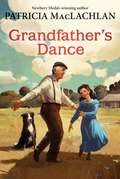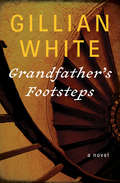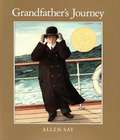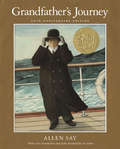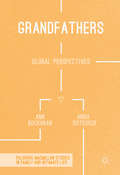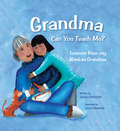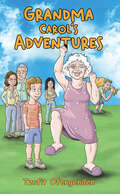- Table View
- List View
Grand Slam: Baseball Genius 3 (Jeter Publishing)
by Tim Green Derek JeterJalen DeLuca applies his baseball genius to his own playing in the follow-up to Tim Green and Derek Jeter&’s New York Times bestselling novel Baseball Genius.Jalen DeLuca loves baseball. But he&’s more than just a fan and a talented player; Jalen is a baseball genius. He can analyze and predict almost exactly what a pitcher is going to do with his next pitch. His unique ability helped him save the career of the Yankees&’s star baseman, James &“JY&” Yager, by signaling the pitches from the stands. Now turning his focus to his own baseball career, Jalen has to put his genius into action in new and untested ways. But without the stats and information he has on the pro players, analyzing the pitchers seems impossible. And even if he knows what the pitch will be, actually hitting it takes more than intuition. As if the pressure of the team and drama with his friends weren&’t enough, one major event changes everything—Jalen&’s mom comes back into his life. Can Jalen work through it all to hit a grand slam and make his baseball dreams a reality?
Grand: A Grandparent's Wisdom for a Happy Life
by Charles JohnsonNational Book Award winner and MacArthur Genius Fellow Charles Johnson reflects on the joys of being a grandparent in this warm, inspiring collection of wisdom and life lessons—the ideal gift for any new parent or grandparentAn award-winning novelist, philosopher, essayist, screenwriter, professor and cartoonist, Charles Johnson has held numerous impressive titles over the course of his incomparable career. Now, for the first time, with his trademark wisdom and philosophical generosity, he turns his attention to his most important role yet: grandparent.In Grand, Johnson shares stories from his life with his six-year-old grandson, Emery, weaving in advice and life lessons that stand the test of time. “Looking at the problems I see in the world around me,” Johnson writes, “I realize that there are so many things I want to say to him about the goodness and beauty that life offers. What are the perennial truths that I can impart to Emery that might make his journey through life easier or more rewarding?” Johnson shares these truths and more, offering profound meditations on family, race, freedom and creativity.Joyful, lucid and deeply comforting, Grand is Johnson at his most accessible and profound, an indispensable compendium for new grandparents and growing grandchildren alike, from one of America’s most revered thinkers.
Grand: A Memoir
by Sara SchaeferFor fans of Mennonite in a Little Black Dress and Let&’s Pretend This Never Happened, comedian and Emmy award–winning writer Sara Schaefer&’s hilariously honest memoir follows Sara&’s trip through the Grand Canyon with her sister that causes her to reflect on her childhood and the scandal that changed her family forever.When Sara Schaefer is in first grade, her father warns her to always tell the truth because one lie leads to another and soon you will find yourself in a hole you can&’t escape. A few years later, the Schaefer family is completely upended when it&’s revealed that their grand life is based on a lie. Her parents become pariahs in their upper middle class community and go from non-religious people to devout church members. The idea of good and evil as binary, opposed forces is drilled into Sara and it becomes the perfect framework on which to build her anxiety and increasingly-obsessive thoughts. The year she turns forty, Sara decides to take each member of her family on a one-on-one vacation culminating with a whitewater rafting journey through the Grand Canyon with her younger sister. The only problem is she&’s terrified of rafting. Along the way, she grapples with unresolved grief over the death of her mother and the family scandal that changed the trajectory of her life. Heartfelt, candid, and witty, Grand is a story about family, identity, and struggling to make something of yourself. Sara deconstructs her struggles with anxiety and depression, what it means to be a good person, and the radically discordant stories we tell ourselves and share with the world.
Grand: Becoming My Mother’s Daughter
by Noelle McCarthy‘A natural storyteller with a Sedaris-like eye for black humour. There are sharp splinters of comic relief … compelling and nuanced.” Edel Coffey, Irish Times Quick-witted, charismatic and generous; angry, vicious and hurt; in pubs all over Cork City, Noelle McCarthy's mother Carol rages against her life and everything she has lost. Soon after leaving college, in the early years of the millennium, Noelle flees. Even on the other side of the world, with fame and success within her grasp, Noelle cannot escape an appetite for self-destruction. Life spirals out of control until she too is in danger of losing everything. At thirty, she pulls back from the brink.Over a decade later, Carol is dying. Finally, it seems, mother and daughter will make peace. Except Carol has no interest in admitting her own mortality - she will die as she lived, entirely on her own terms. If there is any reckoning to be done between past and present, Noelle will be doing it on her own.Grand is the deeply moving and surprisingly funny outcome of Noelle's yearning to understand her mother, and to make sense of their lives, together and apart. Most of all, it is a dazzlingly honest memoir about becoming a modern woman._____2023 Non-Fiction Winner at the Ockham New Zealand Book Awards‘Exquisitely written … profoundly moving. And like all great memoirs it is hilarious in parts. If, like, me, you love the personal essays of Sinéad Gleeson and Emilie Pine, you’ll adore this’ Sunday Independent'Desperately funny, hysterically sad, so beautiful and so humane. All of life is in it' Meg Mason'Hooked me like a fish' New York Times‘A really vivacious account of frayed family relationships across the decades and around the world’ Financial Times Podcast
Grandad Comes to Stay: Independent Reading White 10 (Reading Champion #697)
by Caroline WalkerOliver loves to RUN and he never sits still or moves slowly ... until an injury forces him to take it easy. Lucky for Oliver, Grandad comes round to help, and he is full of great ideas to have fun during Oliver's slow winter! This book is aimed at Independent Reading Book Band White 10, for readers aged from 5-7 years.This story is part of Reading Champion, a series carefully linked to book bands to encourage independent reading skills, developed with Dr Sue Bodman and Glen Franklin of UCL Institute of Education (IOE).Reading Champion offers independent reading books for children to practise and reinforce their developing reading skills.Fantastic, original stories are accompanied by engaging artwork and a reading activity. Each book has been carefully graded so that it can be matched to a child's reading ability, encouraging reading for pleasure.
Grandad's Magic Torch: Independent Reading Turquoise 7 (Reading Champion #691)
by Jill AtkinsThe children are on a camping holiday with Mum and Grandad. And when Grandad lends them his torch, the adventure really begins!Reading Champion offers independent reading books for children to practise and reinforce their developing reading skills.Fantastic, original stories are accompanied by engaging artwork and a reading activity. Each book has been carefully graded so that it can be matched to a child's reading ability, encouraging reading for pleasure.Independent Reading Turquoise 7 stories are perfect for children aged 5+ who are reading at book band 7 (Turquoise) in classroom reading lessons.
Grandad's Medal (Early Reader)
by Phil EarleEarly Readers are stepping stones from picture books to reading books. A blue Early Reader is perfect for sharing and reaading together. A red Early Reader is the next step on your reading journey.Marvin loves going on his adventures with his grandad - escaping from hairy yetis, taking daytrips to Mars, and hunting ferocious tigers - all without leaving the house. Marvin thinks his grandad is the bravest person he's ever met; he even has a medal from the war to prove it. And, more than anything else, Marvin wants to be brave too.But when Grandad must go on his final adventure alone, Marvin finds he has to be braver than he's ever been before. Until he discovers that Grandad has left behind a very special surprise just for him . . . A touching and poignant Early Reader story, perfect for children coming to terms with grief for the first time.
Grandad's Pride (Grandad's Camper)
by Harry WoodgateGrandad and Milly are back for another adventure, this time honoring the past and celebrating the future with a pride parade. This heartwarming tale continues to wonderful journey that began with the Stonewall Honoree and Waterstones Best Illustrated Book, Grandad's Camper."A winner from beginning to end-and affirmation that Pride belongs in every community." - Kirkus Reviews, STARRED REVIEWAfter Milly discovers a pride flag in Grandad's attic, this adorable pair are motivated by the past to start a pride parade in their small town. Activism and celebration go hand in hand as the town gathers to help "build a world where everyone is proud to be themselves." This beautiful follow-up to Grandad's Camper is filled with heart and purpose.
Grandad's Suitcase
by Kathleen P. MunisteriHave you ever wondered why people keep things that are old? Things that are dusty and even broken? Things that don&’t even work anymore? Take a trip with me as I visit my Grandma&’s house and discover things in her attic. Together we learn that we keep things because they are close to our heart. What things do you have that are close to your heart? Share these memories with your friends and family.
Grandad's Wit and Wisdom: Quips and Quotes for Glorious Grandpas
by Richard BensonWhen your roses have been trampled by little feet and the golf has been hijacked by children’s TV, reach for this hilarious book, crammed full of quips and quotes to remind you why being a grandad is one of the best jobs in the world.
Grandad's Wit and Wisdom: Quips and Quotes for Glorious Grandpas
by Richard BensonWhen your roses have been trampled by little feet and the golf has been hijacked by children’s TV, reach for this hilarious book, crammed full of quips and quotes to remind you why being a grandad is one of the best jobs in the world.
Grandaddy's Place
by Helen V. GriffithAt first Janetta does not like Grandaddy, his farm, or his animals--but they like her, and as she gets used to them, she likes them too.
Grandaddy's Stars
by Helen V. GriffithJanetta's Grandaddy lives on a farm with chickens and a mule, and when he comes to visit her in Baltimore, Janetta is worried that he'll find the city boring.
Grandes historias de Isadora Moon 6 - Isadora Moon y el Festival de la Nieve (Grandes historias de Isadora Moon #Volumen 6)
by Harriet MuncasterMitad hada, mitad vampiro, ¡totalmente única! ¡El nuevo libro de Isadora Moon, con actividades y acabados especiales! Isadora Moon es especial porque es diferente. Su mamá es un hada, su papá es un vampiro y ella tiene un poquito de los dos. Isadora está muy emocionada por ir al Festival de la Nieve, la gran celebración del Reino de las Hadas del Invierno. Pero, con tanta gente, Isadora pierde a Pinky. ¿Podrá encontrarlo antes de que se enciendan las lucecitas mágicas? Además, en este volumen de la colección Grandes historias de Isadora Moon, encontrarás el siguiente contenido extra: -¡Actividades superdivertidas! -¡Nuevas manualidades mágicas! -¡Contenido educativo adicional!La colección más encantadora para primeros lectores: -Texto sencillo y entretenido, fácil de leer y de entender para niños y niñas a partir de 7 años. -Capítulos cortos y adorables ilustraciones en rosa y negro en cada página. ¡Ideal para empezar a leer solos! -Del mundo de Isadora Moon y la autora bestseller Harriet Muncaster, con 2 millones de libros vendidos en español. -Con purpurinaen la cubierta, para lectores que quieren flores y magia, pero a los que también les atrae el mundo misterioso de los vampiros.
Grandfather Counts
by Andrea ChengWhen her mother's father comes from China, Helen, who is biracial, develops a special bond with her grandfather despite their age and language differences.
Grandfather and the Moon
by Stéphanie LapointeAn award-winning graphic novel from Quebec — for fans of Jane, the Fox and Me and A Year Without MomThis moving graphic novel tells the story of the affection between a girl and her grandfather. When the grandfather withdraws in grief after his wife dies, the girl is determined to live life fully herself and enters an extraordinary contest — the result is a sensitive portrayal of pursuing a dream.Grandfather, a man of few words, is devastated when his beloved wife succumbs to cancer, and he sinks into depression. His granddaughter (“Mémère,” as he calls her) has a different response. She decides to enter the Who Will Go to the Moon Contest, and when she actually wins, she hopes that Grandfather will be proud of her. She embarks on the thrilling journey and at first it is wonderful, but just as she is about to reach the moon, her journey takes an unexpected turn.Written by Stéphanie Lapointe and beautifully illustrated by Rogé, this imaginative graphic novel explores intergenerational relationships, love, death, dreams and illusions.Correlates to the Common Core State Standards in English Language Arts:CCSS.ELA-LITERACY.RL.5.1Quote accurately from a text when explaining what the text says explicitly and when drawing inferences from the text.CCSS.ELA-LITERACY.RL.5.6Describe how a narrator's or speaker's point of view influences how events are described.
Grandfather's Dance (Sarah, Plain and Tall #5)
by Patricia MaclachlanCould anything be more perfect than a prairie wedding? <P><P>Cassie doesn't think so, for a wedding brings: Two lovebirds together, Aunts from faraway Maine, A long white dress with a wedding veil, Zinnias, Satin ribbons, Dancing under a clear blue sky, And a world that smells of roses. <P><P>And as the Witting family comes together for this most special day, Cassie sees that life brings: The change of seasons, Brother Jack on Grandfather's lap, A brand-new car, Joy, Sorrow, And a special dance only Grandfather does. Sarah, Plain and Tall began the Witting family's saga on the prairie. <P><P>Now the story completes its circle with Grandfather's Dance, Patricia MacLachlan's poetic celebration about the enduring spirit of family.
Grandfather's Footsteps: A Novel
by Gillian WhiteJessica&’s scheme was supposed to get her a new baby—but she didn&’t count on getting an entire familyJessica was living the perfect London life, with a great job at an auction house and a striking Italian boyfriend, Rudi. Only one thing was missing: a baby. Despite numerous visits to the doctor and repeated efforts to conceive, the couple was having no luck. That is, until Brenda, Jessica&’s secretary, became pregnant. Jessica&’s plan is as dishonest as it is effective. She will have Rudi sleep with the barely pregnant Brenda, and trick him into believing that the secretary is carrying his child. Then Jessica and Rudi can adopt the baby. But a twist of fate upsets Jessica&’s scheme when Brenda&’s brassy, working-class family becomes a fixture in her life, giving her endless headaches as they invite themselves over for visits and hospital trips. After one underhanded ploy, Jessica must deal with a family she never wanted and one that is almost impossible to avoid.
Grandfather's Journey
by Allen SayA picture book masterpiece from Caldecott medal winner Allen Say. Lyrical, breathtaking, splendid--words used to describe Allen Say's Grandfather's Journey when it was first published. At once deeply personal yet expressing universally held emotions, this tale of one man's love for two countries and his constant desire to be in both places captures readers' attention and hearts. Images and descriptions available.
Grandfather's Journey
by Allen SayWhen he was a young man, Allen Say's grandfather left his home in Japan to explore the world. He began his journey by crossing the Pacific Ocean on a steamship, then wandered the deserts, farmlands, and cities of North America. Allen Say lovingly tells the story of his own family's cross-cultural history in elegant watercolor paintings that earned him a Caldecott Medal in 1994. This twentieth-anniversary edition of the modern classic features read-aloud audio and a new introduction by Allen Say.
Grandfather's Wrinkles
by Kathryn England Richard McFarlandLucy and her grandfather are the focus of this poignant and warm story that teaches that wrinkles are badges of happiness rather than signs of age. Lucy asks granddad, “why doesn't your skin fit you? It’s all crinkly,” to which he replies, “those crinkles are called wrinkles,” Each of which he got when he smiled especially big. As Lucy traces granddad’s joy-filled face, he describes his memories and shares the cause of each line—his wedding day, Lucy’s mother’s birth, precious moments from her childhood, and Lucas birth, among others. Beautiful drawings recreate each thoughtful memory, and the recollections showcase an intimate bond between the two generations.
Grandfather's Wrinkles
by Kathryn England Richard McFarlandLucy and her grandfather are the focus of this poignant and warm story that teaches that wrinkles are badges of happiness rather than signs of age. Lucy asks Granddad, “Why doesn't your skin fit you? It's all crinkly,” to which he replies, “Those crinkles are called wrinkles,” each of which he got when he smiled especially big. As Lucy traces Granddad's joy-filled face, he describes his memories and shares the cause of each line—his wedding day, Lucy's mother's birth, precious moments from her childhood, and Lucy's birth, among others. Beautiful drawings recreate each thoughtful memory, and the recollections showcase an intimate bond between the two generations.
Grandfathers
by Ann Buchanan Anna RotkirchThis is the first book to bring together international scholars from around the world and from a wide variety of disciplines, to discover what is known about grandfathers and analyse the impact of close involvement with their grandchildren. Within the context of increased divorce rates, single parent families and healthier, more active elders, grandfathers have come out of the shadows and re-invented themselves in a new caring, nurturing role. These original studies demonstrate that grandfather involvement is independently and positively associated with higher levels of child well-being in the UK and South Africa, as well as in Arab and Israeli teenagers, and pre-school children in England. The chapters conclude that societies could benefit from encouraging more grandfathers to become actively involved in their grandchildren's lives and argues the case for grandparent visitation rights in those countries that currently do not have them.
Grandma Can You Teach Me?
by Jacqui ErtischekTeach me to dance, to cook and to sew. Teach me to fish and help me to grow. This is a wonderful story of a young girl staying for the day with her grandma. Grandparents and Grandchildren all over the world will understand and appreciate the love and joy of spending time with each other.
Grandma Carol's Adventures
by Tzofit OfengendenNine-year-old Leo loves his strong-willed, funny, and quirky Grandma Carol, even though her memory problems create all sorts of adventures. After a fire breaks out in Grandma Carol’s living room, Leo’s Mom and Dad decide to hire a caregiver to live with her. Leo is no longer allowed to spend as much time with her as he wants to. But Carol, who has always been a free spirit, is not willing to lose her independence: she plays tricks, hides, and even goes so far as to run away from her caregiver. Then, one night, a thief with extra-long arms arrives at Grandma’s apartment building… Tzofit Ofengenden’s comic novel, told from Leo’s innocent but sharp-eyed point of view, is well-observed and cleverly plotted, with wonderfully surreal touches.
